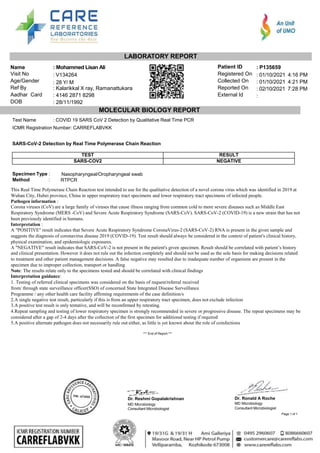Report
Share

Recommended
More Related Content
What's hot (20)
Similar to Rtpcr
Similar to Rtpcr (20)
More from Care Reference Laboratory
More from Care Reference Laboratory (20)
Recently uploaded
Recently uploaded (20)
Introducing VarSeq Dx as a Medical Device in the European Union

Introducing VarSeq Dx as a Medical Device in the European Union
Circulation through Special Regions -characteristics and regulation

Circulation through Special Regions -characteristics and regulation
TEST BANK For Huether and McCance's Understanding Pathophysiology, Canadian 2...

TEST BANK For Huether and McCance's Understanding Pathophysiology, Canadian 2...
Cas 28578-16-7 PMK ethyl glycidate ( new PMK powder) best suppler

Cas 28578-16-7 PMK ethyl glycidate ( new PMK powder) best suppler
Integrated Neuromuscular Inhibition Technique (INIT)

Integrated Neuromuscular Inhibition Technique (INIT)
CURRENT HEALTH PROBLEMS AND ITS SOLUTION BY AYURVEDA.pptx

CURRENT HEALTH PROBLEMS AND ITS SOLUTION BY AYURVEDA.pptx
Denture base resins materials and its mechanism of action

Denture base resins materials and its mechanism of action
Scientificity and feasibility study of non-invasive central arterial pressure...

Scientificity and feasibility study of non-invasive central arterial pressure...
Compare home pulse pressure components collected directly from home

Compare home pulse pressure components collected directly from home
Muscle Energy Technique (MET) with variant and techniques.

Muscle Energy Technique (MET) with variant and techniques.
Why invest into infodemic management in health emergencies

Why invest into infodemic management in health emergencies
TEST BANK For Timby's Introductory Medical-Surgical Nursing, 13th Edition by ...

TEST BANK For Timby's Introductory Medical-Surgical Nursing, 13th Edition by ...
TEST BANK for The Nursing Assistant Acute, Subacute, and Long-Term Care, 6th ...

TEST BANK for The Nursing Assistant Acute, Subacute, and Long-Term Care, 6th ...
Rtpcr
- 1. LABORATORY REPORT : P135659 : 01/10/2021 4:16 PM : 01/10/2021 4:21 PM : 02/10/2021 7:28 PM : Patient ID Registered On Collected On Reported On External Id : Mohammed Lisan Ali : V134264 : 28 Y/ M Name Visit No Age/Gender Ref By Aadhar Card DOB : Kalarikkal X ray, Ramanattukara : 4146 2871 8298 : 28/11/1992 MOLECULAR BIOLOGY REPORT Test Name : COVID 19 SARS CoV 2 Detection by Qualitative Real Time PCR ICMR Registration Number: CARREFLABVKK SARS-CoV-2 Detection by Real Time Polymerase Chain Reaction TEST RESULT SARS-COV2 NEGATIVE Specimen Type : Method : Nasopharyngeal/Oropharyngeal swab RTPCR This Real Time Polymerase Chain Reaction test intended to use for the qualitative detection of a novel corona virus which was identified in 2019 at Wuhan City, Hubei province, China in upper respiratory tract specimens and lower respiratory tract specimens of infected people. Pathogen information : Corona viruses (CoV) are a large family of viruses that cause illness ranging from common cold to more severe diseases such as Middle East Respiratory Syndrome (MERS -CoV) and Severe Acute Respiratory Syndrome (SARS-CoV). SARS-CoV-2 (COVID-19) is a new strain that has not been previously identified in humans. Interpretation : A "POSITIVE" result indicates that Severe Acute Respiratory Syndrome CoronaVirus-2 (SARS-CoV-2) RNA is present in the given sample and suggests the diagnosis of coronavirus disease 2019 (COVID-19). Test result should always be considered in the context of patient's clinical history, physical examination, and epidemiologic exposures. A "NEGATIVE" result indicates that SARS-CoV-2 is not present in the patient's given specimen. Result should be correlated with patient’s history and clinical presentation. However it does not rule out the infection completely and should not be used as the sole basis for making decisions related to treatment and other patient management decisions. A false negative may resulted due to inadequate number of organisms are present in the specimen due to improper collection, transport or handling Note: The results relate only to the specimens tested and should be correlated with clinical findings Interpretation guidance: 1. Testing of referred clinical specimens was considered on the basis of request/referral received from/ through state surveillance officer(SSO) of concerned State Integrated Disease Surveillance Programme / any other health care facility affirming requirements of the case definition/s 2.A single negative test result, particularly if this is from an upper respiratory tract specimen, does not exclude infection 3.A positive test result is only tentative, and will be reconfirmed by retesting. 4.Repeat sampling and testing of lower respiratory specimen is strongly recommended in severe or progressive disease. The repeat specimens may be considered after a gap of 2-4 days after the collection of the first specimen for additional testing if required 5.A positive alternate pathogen does not necessarily rule out either, as little is yet known about the role of coinfections *** End of Report *** Page 1 of 1 Dr. Ronald A Roche MD Microbiology Consultant Microbiologist Dr. Reshmi Gopalakrishnan MD Microbiology Consultant Microbiologist